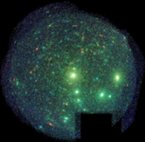 Among the Stars
Among the Stars
The association of stars known as Cygnus OB2 has a storied X-ray history. Early observations with the Imaging Proportional Counter on the Einstein X-ray Observatory reported back in 1979 provided some of the first evidence of a "new class of low-luminosity galactic X-ray sources". These initial observations found 6 or so individual sources, massive stars which produce X-rays (as we know now) either from instabilities in their strong stellar winds, or, in binary star systems, from the collision of the wind from one star with that of its companion. Since that time, Cygnus OB2 has been a popular target for astronomers, including (especially) X-ray astronomers. The image above shows a deep montage of X-ray observations of Cygnus OB2 obtained by the X-ray cameras on the XMM-Newton X-ray observatory. In addition to the 6 sources detected by the Einstein X-ray observatory, XMM-Newton detects thousands of fainter sources, including a large population of low-mass stars which generate X-rays from intense, unstable magnetic fields. These X-ray studies reveal the connection between the formation of high and low mass stars in Cygnus OB2 and similar clusters.
ESA: X-raying Colliding Stellar Winds
| << Previous HEAPOW | High Energy Astrophysics Picture of the Week | Next HEAPOW >> |